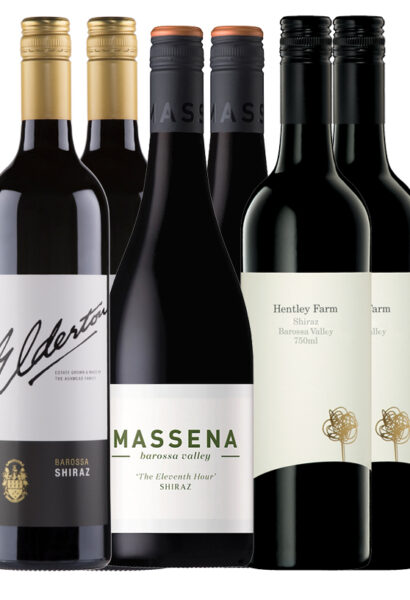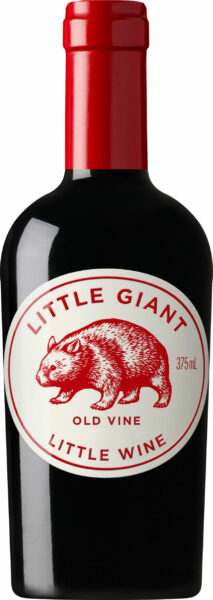Shiraz
Showing 1–16 of 20 results
Filter-

Mixed cases
Barossa Shiraz Mixed Case of 6
$224.00Min. Quantity: 1
-

Red Wine
Elderton Barossa Shiraz
$35.80Min. Quantity: 3
-

Shiraz
Hentley Farm Barossa Valley Shiraz
$37.90Min. Quantity: 3
-

Red Wine
Plus & Minus Zero Alcohol Shiraz
$14.00Min. Quantity: 3
-

Shiraz
Penfolds St Henri Shiraz
$132.00Min. Quantity: 1
-

Minis & Magnums
Little Giant Little Wine Red Blend 375ml
$14.50Min. Quantity: 12
-
 92points
92pointsShiraz
Guigal Saint Joseph Rouge
$72.30Min. Quantity: 1
-
 93points
93pointsShiraz
Guigal Crozes Hermitage Rouge
$59.90Min. Quantity: 3
-

Shiraz
Langmeil The Freedom 1843 Shiraz
$165.00Min. Quantity: 1
-

Red Wine
Dandelion Lionheart of the Barossa Shiraz 375mL
$13.00Min. Quantity: 10
-

Shiraz
Ministry of Clouds McLaren Vale Shiraz
$30.00Min. Quantity: 3
-

Shiraz
Massena The Eleventh Hour Shiraz
$38.50Min. Quantity: 2
-

Shiraz
John Duval Entity Shiraz
$50.40Min. Quantity: 3
-

Shiraz
Amon Ra Shiraz
$86.70Min. Quantity: 1
-

Shiraz
Penfolds RWT Bin 798 Barossa Valley Shiraz gift box
$198.00Min. Quantity: 1
-

Shiraz
Jim Barry McRae Wood Clare Valley Shiraz
$55.40Min. Quantity: 1
Shiraz Overview
The origins of Shiraz vines are a little vague, but they appear to have been first cultivated in the Rhone Valley in France during Roman occupation. Shiraz, or Syrah as it is known in France and America, appears in some of France’s most famous wines: Cote Rotie, Hermitage and as a blend in Chateauneuf du Pape. Shiraz made its way to Australia through several cuttings brought out by James Busby in 1832 as part of his collection of vines that he gathered during his European tour. Shiraz is one of the most adaptable red grape varieties in the world, growing in a vast array of environmental conditions and producing wine styles from lean, restrained, aromatic cool climate styles through to big, luscious, mouth-filling wines.
The French and Americans call it syrah. In Australia we call it shiraz.
Like chardonnay’s red equivalency, shiraz tends to adapt well to a wide range of growing environments and produces an extremely wide variety of styles, from lean, restrained, aromatic cool climate styles through to big, luscious, mouth filling wines that leave a permanent mark on our memory with their sheer size and intensity. The style of wine shiraz makes is influenced by many factors including climate, viticultural practices and winemaking techniques, as well as more than a dash of cultural (or local) preferences.
Style & Characteristics
Cool climate Shiraz
- Elegant & textured.
- Distinct white pepper characters and other flavours including berry fruits, savoury & spice.
- Dusty, grainy & drying tannins.
- Age extremely well. With age the astringency decreases & mouthfeel becomes more velvety & smooth.
- Regions include: Grampians (Great Western), Clare Valley & Coonawarra.
Warm climate shiraz
- Complex & richly flavoured.
- Flavours including plums, liquorice, chocolate.
- Tannins in abundance give a mouth puckering sensation,
they have higher alcohol and fruit richness. - Longer ageing potential than cool climate Shiraz. As they age complexity builds.
- Regions include: McLaren Vale, Langhorne Creek, Barossa Valley.
Key facts about shiraz.
- Original Shiraz vines brought to Australia from France in 1832 by James Busby.
- An extremely adaptable variety, grown in many diverse environmental conditions throughout the world.
- Shiraz is the popular Australian synonym for syrah. It is a mark of Australia’s success with shiraz that France has endorsed shiraz as an acceptable legal name for syrah in wines produced there, and Californian producers are as likely to label their wine shiraz as they are syrah.
- Shiraz is a naturally vigorous vine, growing right across Australia’s wine regions producing styles that reflect its different origins.
- Shiraz loves oak and in Australia it has demonstrated a particular affinity for American oak. American oak complements the tannin structure and produces great harmony on the finish.
- With shiraz wines in our cellars dating back to the 1950s, it’s safe to say shiraz can, and does, age beautifully. The colour of shiraz will range from medium red to a deep rich purple to almost black. With age, you can expect the colours to range from brick red to tawny. You can expect a smorgasbord of primary aromas including blackberry, plum, black olives and more. With age, developed fruit aromas show, like cigar-boxes, prune and chocolate. Shiraz makes wines with richness, ripeness and spiciness. Evident, but well-rounded tannins give structure. The mid-palate shows ripe and round fruit that give a silky, smooth mouthfeel, softer than that of cabernet sauvignon.
Shiraz is the main protagonist in the varietal makeup of a number of the icon wines of Australia.
Shiraz in Australia
Shiraz was one of the first grape varieties planted in Australia. First it served as a base for fortified wines and has been a cornerstone in the history of the Australian wine industry ever since.
Its fortunes have ebbed and flowed, however. In the 1980s when red wine, and shiraz in particular, was unpopular, the South Australian government was literally paying growers to grub up (or dig up) their vineyards.
Fortunately for wine lovers the world over, the quality of the wine made from low yielding, dry-grown shiraz vines recaptured the attention of the wine trade and media, and since the mid 1980s Australian shiraz has never looked back.
These old vineyards are, today, as prized as any viticultural land in the country!
Shiraz is now Australia’s most widely planted red variety, growing well across most key wine regions. This regional diversity offers a number of shiraz styles that capture both the essence of the variety and the terroir.
Australian Styles of Shiraz
1) Everyday shiraz
These juicy wines are fresh, generous, rich and spicy. These wines are designed for early drinking and have a noticeable vibrancy of fruit, freshness and vivacity. The use of blending older vine components and the judicious use of oak however gives them a rich and powerful core, that can take the unsuspecting drinker by surprise.
2) Cooler-climate shiraz
Elegant, spicy and vibrant expressions of their origins – proof that shiraz can adapt growing almost anywhere. Tasting cool-climate shiraz wines, you will notice a lighter palate weight, more structured tannins, higher natural acidity and distinctive spicy, peppery tones. These characters complement their ripe berry, plum and anise aromas and flavours. Cooler-climate shiraz wines show great elegance and silkiness. Grape yields in cooler climates have to be lower, and as a result, overall production costs are higher than those associated with everyday wines. But if you want something out of the ordinary and distinctively individual, cool climate shiraz wines are hard to beat!
3) Warmer-climate shiraz
The powerhouses of the Australian wine industry – they present rich, full and ripe wines with a depth and complexity to match. Tasting warm climate shiraz – you will notice a much heavier palate, densely packed with complex primary and developed fruit characters. American oak adds to the soft nature of these wines. Tannic in their youth, they develop a round, silky supple texture and wonderous camphor, earth and chocolate nuances with age. And age they will, the fruit is so powerful and intense, these wines will mature, quite literally for decades! To make these powerful, age-worthy wines, winemakers have to work very hard with shiraz in both the vineyard and the winery. The fruit is harvested very ripe and the winemakers then get stuck into the labour-intensive winemaking process. Basket presses, open fermenters, as well as pumping over, or hand plunging the caps are all used to extract the utmost colour and flavour from these vinous heavyweights. Even the methods of maturation in American oak is cause for winemakers to take critical style decisions, based on their judgement of the wine as it goes through fermentation. Some wine will finish the ferment in barrels to improve the oak, fruit and tannin integration. Other wines will macerate on skins for days, after the fermentation. For most iconic Australian shiraz wines, an extended period in the bottle is also required before release. You may have to wait between 2 and 5 years before you can add them to your cellar.
